-
American Goldfinch (1)
-
American Robin (1)
-
Baltimore Oriole (1)
-
Blue Jay (0)
-
Bluebirds (1)
-
Carolina Wren (0)
-
Chickadee (0)
-
Ducks (1)
-
Starling and House Sparrow (1)
-
House Finch (0)
-
House Wren (0)
-
Hummingbirds (5)
-
Northern Cardinal (1)
-
Northern Mockingbird (1)
-
Nuthatch (0)
-
Owls (3)
-
Tufted Titmouse (0)
-
Woodpeckers (0)
Glass vs Plastic - Selecting the Right Hummingbird Feeder
Hummingbirds have uniquely high metabolisms that keep them busy searching for and eating food for the most part of their days. Most people would be surprised to know that a hummingbird’s diet consists of insects like ants, mosquitoes, gnats, and small spiders. These bugs help fill their stomach and provide them with protein. But it is most commonly known that these small, fluttering birds consistently seek out and need nectar to supplement their diet and overall well-being.

There are several benefits to having a hummingbird feeder, especially if one is wanting to attract them to their garden or backyard. But hummingbird feeders and nectar are known for potentially attracting other birds too!
Some other feathered friends that could make a pit stop for a quick rest and sweet drink include orioles, grackles, finches, warblers, flickers, and titmice. During migration season it can be helpful to spread out feeders with nectar to help ensure all hummingbirds and their other friends in flight have access to the healthy resources they need to complete their journey.
The best time to put out a hummingbird feeder is by Mid-March thru May. It can be helpful to install feeders by flowers that hummingbirds prefer to feed from or near a garden, though it is not necessary.

All of this can lead to one big, very important question. What type of hummingbird feeder is best?
Two main materials that hummingbird feeders are made out of are plastic and glass. JCs Wildlife offers a third option that can accompany and hold either plastic or glass jars made specifically to hold nectar. Recycled poly lumber is a type of material mostly made out of recycled milk jugs that can last a lifetime! At the end of the day, the choice ultimately comes down to personal preference, but there are lots of pros, and a few cons, to either of these options.
While plastic can be a bit of a dirty word to those trying to help preserve Earth and all its natural resources, it is still used for several reasons.
Plastic hummingbird feeders provide a more affordable option for those who don’t want to dig too deep in their pocket. It is lightweight and less likely to break or be damaged during unfavorable weather. Plastic feeders can have long lifespans that do not need to be replaced too often, however, they are also known to warp, fade, and crack over time. This is especially true in regions that experience extreme heat and humidity.
If a plastic feeder is not cleaned and maintained properly a few times a week during hummingbird season the sugar can begin to erode the plastic from the inside. If seeking out a plastic hummingbird feeder it is important to look for food safe, BPA-free options. This will help ensure less chemicals from the plastic seep into the nectar overtime, and will be less harmful to hummingbirds over time as well. Plastic hummingbird feeds tend to come mostly in traditional, basic styles and colors (variations of red and clear) with very little design.
On the opposite end of the spectrum, glass can be heavier, more expensive, and fragile compared to its plastic competitors. However, it has its own perks.
Unlike plastic, glass hummingbird feeders can potentially help preserve fresh nectar and does not heat up as quickly internally. Glass will not warp or fade overtime, and as long as it doesn’t break and is cleaned and maintained properly, it may not ever need to be replaced. The sugar will not erode the walls of a glass reservoir and can be easier to clean. Glass is more eco-friendly and can be recycled if desired to retire the feeder or if it becomes damaged and irreplaceable. Glass hummingbird feeders come in a variety of designs, shapes, and colors that can bring style and personality to any personal space.

Saucer Feeder
Saucer feeders are also well-known to be leak proof because of the dish design. The bottom reservoir that holds the nectar is clear so it is easy to see when it is ready for a refill. Multiple ports provide enough space for multiple hummingbirds to feed at a time.
Saucer feeders check everything off the list to ensure practical, simple, and beautiful hummingbird watching.

Classic Feeder
New to the world of feeding hummingbirds? Start with a classic sugar water feeder.
Coated in a signature bright red helps attract hummingbirds to any yard or garden. This feeder is constructed with easy-to-fill, wide-mouth plastic cylinder jar and two-part bases. This makes filling and cleaning a breeze.
Fill with nectar of your choice of a pre-made or a home made recipe, but skip the red dye as it is not needed and can potentially hurt the hummingbirds in the long run.
These feeders are generally very affordable so simply hang one, two, or three and enjoy watching the hummingbirds flock to your yard for a tasty treat and much needed rest!

Hummingbird Bar Feeder
Hummingbird bar feeders serve one main purpose. To attract and feed numerous hummingbirds at one time.
This particular feeder can be a bit controversial as hummingbirds are known to be territorial birds and like their space when it comes to meal time. However, hummingbird bar feeders can be a great addition to any area that already has a strong hummingbird presence with a feeder or two already set up.
The clear plastic tube holds the nectar and has up to 22 feeding ports and provides easy visibility for not just for the bird watcher, but does not hinder the hummingbird's view of potential danger while feeding.
This feeder hangs horizontally and needs to be installed as evenly as possible to ensure no leaking.

Classic Glass Feeder
Simply uncap the lid at the top of the feeder and fill with the preferred nectar of choice. The feed ports mimic flowers that hummingbirds are known to like to visit. The perch provides a comfortable place for the hummingbird to rest while it sips and refreshes on its journey.
Clean and maintain with a brush and some water, and be mindful of unfavorable weather, and this glass feeder is sure to last a lifetime.

Colored Glass Feeders
Studies have shown that hummingbirds are also able to register the color purple very well, as well as deep hues of oranges and yellows. If you don’t like red, or just want to switch things up for a bit, try a purple glass feeder like this one!
There is no need to worry about inverting the glass bottle as the top has a wide-mouth opening, top-fill design for mess-free refills! The base is sealed to ensure there are no leaks. The feeding ports are soft and flexible and mimic the flowers that hummingbirds enjoy feeding from in nature. It’s a great option to be pretty and practical all at the same time!

Antique Inspired Glass Bottle
There are numerous vintage and antique-like bottle hummingbird feeders that mimic the days of when the hummingbird feeder was first introduced to backyards that are often seen in transparent greens, browns, and colorless clear bottles.
This transparent green glass will not only give your backyard a vintage feel, but it allows a clear, visible view of the nectar level when in use. The feed ports provide just enough hint of red for the hummingbirds to see and enjoy feeding.

JCs Wildlife Recycled Poly Lumber Nectar DOTs Holder
Recycled Poly Lumber is fade and weather resistant and will last through many seasons. This material is made mostly out of recycled milk jugs, making it eco-friendly and extremely durable. The color red will attract the hummingbirds to feed from the jars, or Nectar DOTS, that hold nectar.
The lid doubles as the feeding port. Cleaning and refilling is a breeze. Simply lift the jar out of the poly lumber holder, unscrew the lid top, and scrub and refill as needed. An O ring is attached on the top of the poly lumber holder and can easily hang from your favorite pole.
Hummingbird feeders are offered in a variety of styles, designs, and materials. Ultimately, any of these options will provide an enjoyable experience for any thirsty hummingbird. The choice comes down to benefits for each individual personality and lifestyle.
Check out JCs Wildlife for a large selection of hummingbird feeders, nectars, cleaning brushes, and more!
No comments

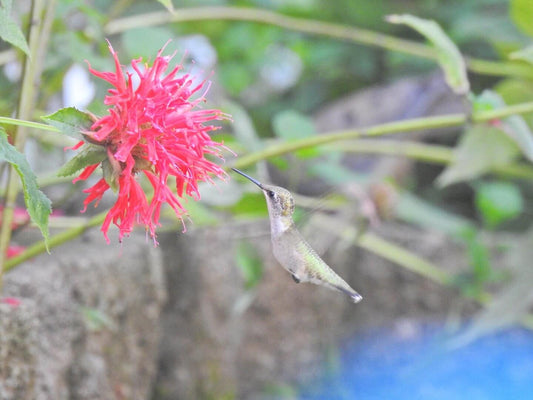
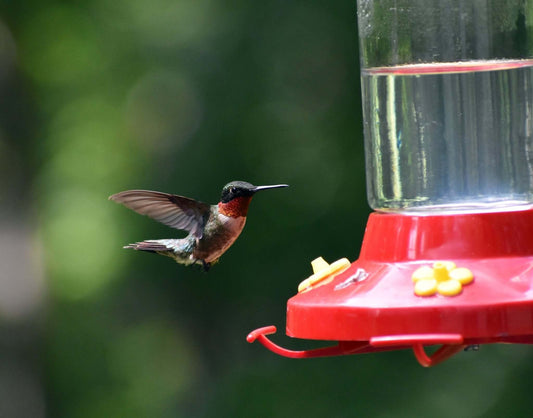
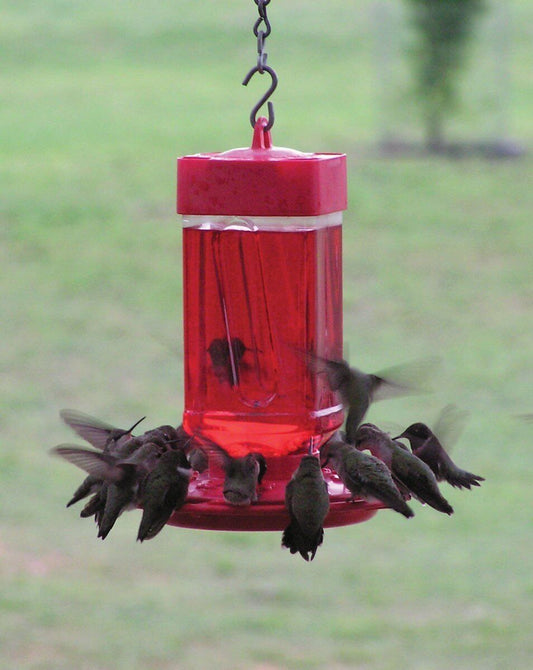
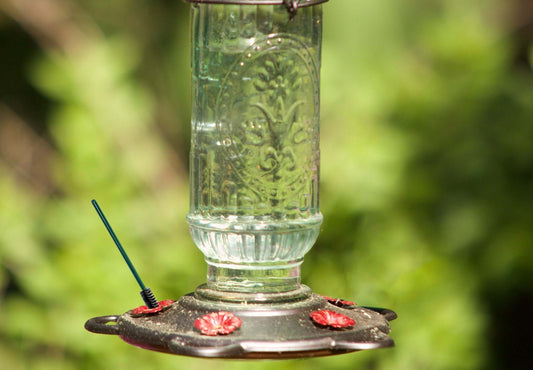
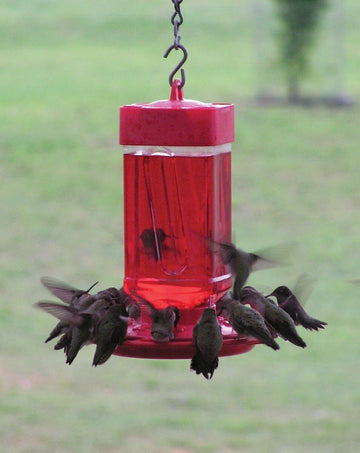
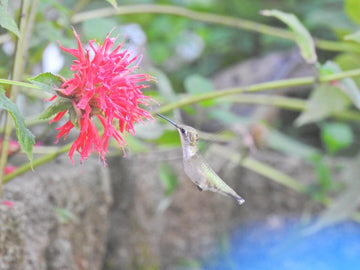

0 comments